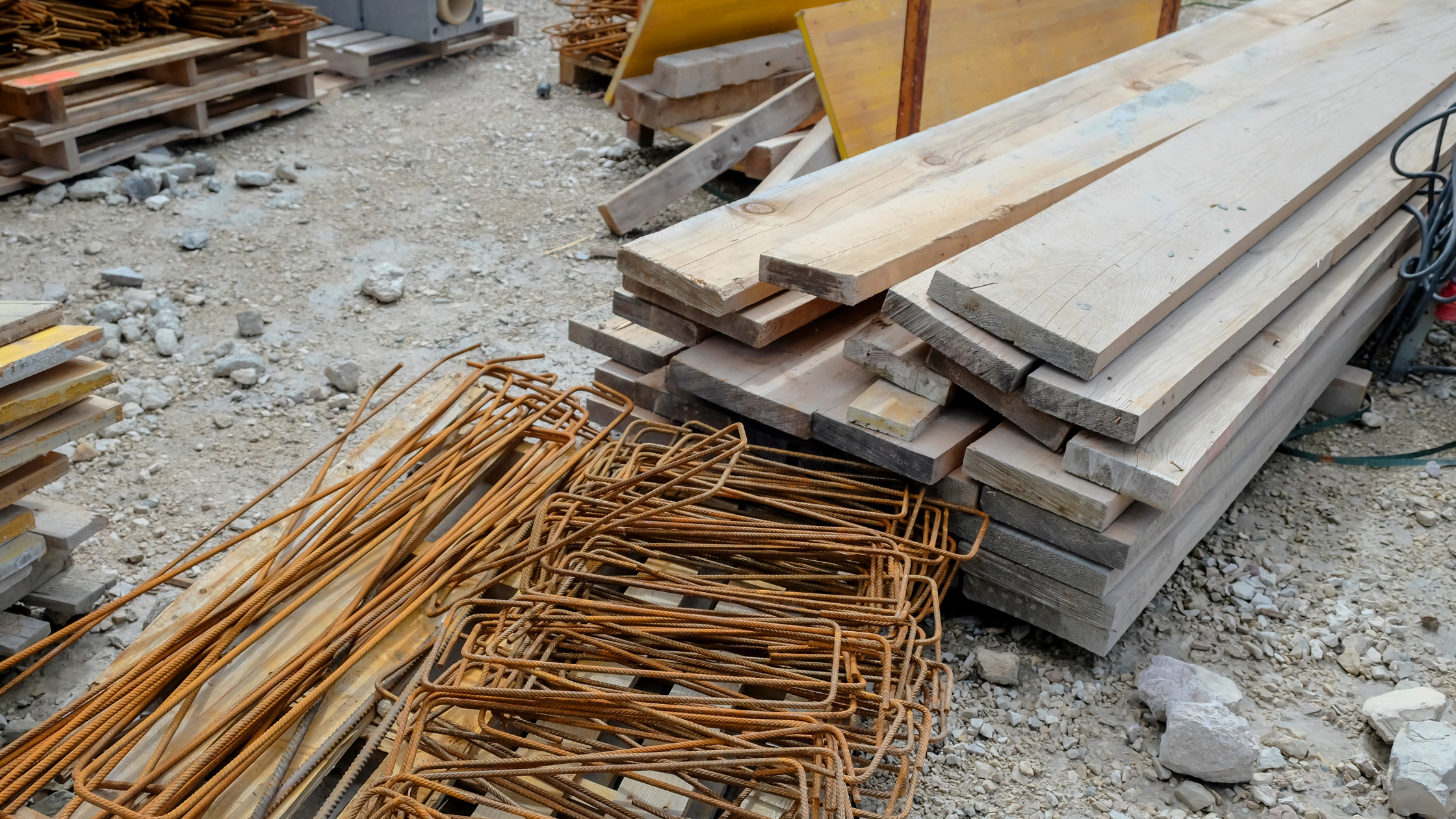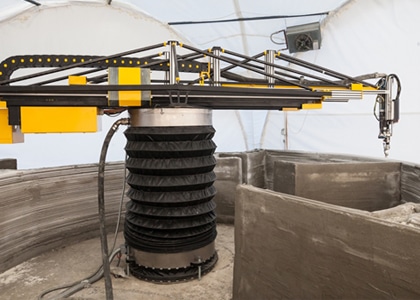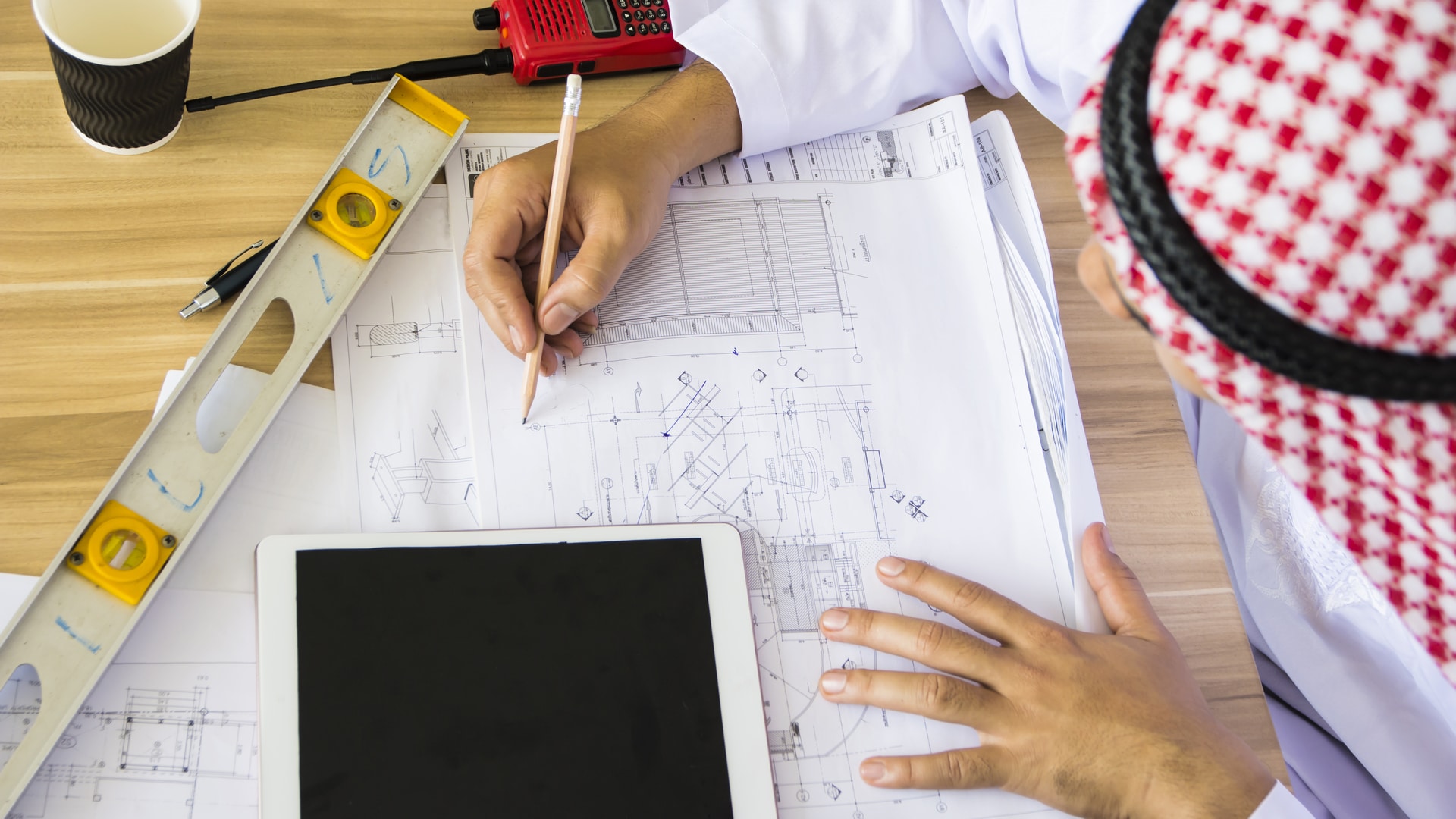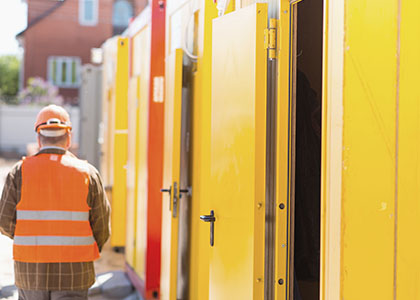Home / Blog / 4 ways to reliably build material sourcing in post covid-19 saudi
SUMMARY
There’s no denying that the COVID-19 pandemic has impacted the construction industry in Saudi. As projects were delayed through tough lockdowns, companies like yours are most likely looking to complete existing developments on time and on budget, as well as win new work. One way to do this is to plan for contracts where you are offering lower cost-to-build estimates. Another is to address the disruptions on your supply chain by turning to more local sources and factoring increased flexibility into your processes.
Without a doubt, the pandemic significantly impacted global supply chains for goods, materials, and equipment, due to both a decline in output in Chinese manufacturing, as well as disruptions to international logistics. These challenges have forced a lot of Saudi companies to rethink their sourcing and pricing strategies.
A return to profitability in 2021 will mean strategically diversifying your supply chains towards more local vendors. This article addresses ways you can build reliable material sourcing supply chains next year so that you can return to projects stronger and more resilient.
INDEX
- Understand the role of disruptions on global supply chains
- Balance budgets next year
- Diversify supply chains
- Build supply chain resilience
4 WAYS TO RELIABLY BUILD MATERIAL SOURCING IN POST COVID-19 SAUDI


Almost nobody anticipated a global pandemic that would impact entire sectors of economies. Prior to the COVID-19 outbreak, Saudi Arabia’s construction sector had posted growth for the first time in four years, expanding by 4.1% in 2019. However, owing to low oil prices and the impact of the pandemic outbreak, the construction industry is expected to be facing a 1.8% contraction in 2020[1]. This is partially due to a globalized economy, which relies on China, Mexico, and Canada for 70% of its material requirements, facing unprecedented supply-chain disruptions.
As a result of the pandemic and its subsequent government-ordained lockdowns, construction work came to a standstill in the Kingdom, and prices of goods and materials increased substantially. Construction projects that were heavily reliant on China for plumbing components, elevator parts, fire protection items, and electrical materials, among other hardware, needed to quickly rethink sourcing strategies once markets reopened. Similarly, vendors sourcing glass and aluminum from across Europe—mostly from Spain, Italy, and Lithuania, had to scramble for other material suppliers if they hoped to deliver on existing projects. These set companies back on timelines and budgets.
While manufacturing and logistics functions are resuming in most countries, the pandemic has come as a lesson for industry sectors. It is forcing organizations to analyze internal functions to identify weaknesses so that they can set up processes that make them immune to future events like the COVID-19 pandemic. One way to do this is to build stronger supply chains for the future. Four ways you can do this are listed below:
-
Understand the role of disruptions on global supply chains
At the peak of the pandemic, global shipping has been one of the biggest casualties. As more container ships idled around the world, and containers of supplies faced extended delays at docks before clearance, many construction companies faced back orders. Additionally, longer lead times on finishing materials like glass office fronts and stone coming from Italy also added to construction costs and deliverables.
You need to understand that in a globalized economy, there is always a great deal of interdependence. That is why when there were lockdowns, many building material components were impacted. These included:
- HVAC system materials: Parts such as fans, compressors, control panels, and condensers are largely manufactured in China and South Korea.
- Elevator components: Motors for several of the large elevator manufactures are produced in China. Even with markets now open, construction projects are anticipating delays on high-rise elevator manufacturers by all vendors.
- Plumbing materials: Compressor fittings are manufactured in Germany and materials such as drains, carriers, and plumbing fixture components are manufactured in China.
- Flooring materials: 35-40% of porcelain tile and custom glass tile products are manufactured in Italy and China. Natural stone used across high-end projects is also sourced largely from Italy. LVT and rolled rubber materials products that are widely used in Saudi construction come from China.
- Division items: Items such as cubicles, vents, corner guards, flooring, lockers, shelving have been seeing extended lead times of 2-3 weeks. Window treatment items were looking at almost 12-to 20-week delays.
- Hardware materials: Hardware for lab casework and millwork is delaying the supply of these products. Much of it is manufactured and supplied by China.
- Fire protection materials: Long-lead items like pumps, controllers, pressure switches, water flow switches, tamper switches, and grooved fittings are sourced from China.


- Glass, aluminum materials: Glass and aluminum products are largely manufactured outside Saudi, including in Italy, Lithuania, and Spain. Window and curtain wall materials sourced from Italy have also been impacted.
- Electric materials: Lead times on switchgear were facing typically 10-to 20-week delays, whereas lead times on lighting fixtures were anywhere from 6 to 12 weeks.
How delays are impacting your business
As of 2019, China is Saudi Arabia’s biggest trading partner with an 18.7% ($27 billion) share. There has already been a significant impact on global supply chains for goods, materials, equipment, and plants due to a substantial decline of output in Chinese manufacturing, as well as export and logistics issues. Particularly, the extended closure of factories in China after the Lunar New Year holiday, substantially reduced manufacturing and resulted in supply shortages of materials or finished goods. Furthermore, logistics issues have already greatly impacted exports and supplies of materials and equipment coming from or routed through, impacted areas. The backlog is expected to continue well into next year.


Companies with projects in the Kingdom and in the broader region, consequently, need to source goods that are not imported or are available through alternative supply chains than what you are using. Additionally, you need to assess whether products and materials such as stone, steel, cladding and façade materials, equipment for MEP (Mechanical, Electrical, and Plumbing) works and other high-tech equipment amongst other things, can be substituted through local vendors.
If you want to mitigate delays and additional costs on projects, you need to consider sourcing through reputable local names and companies. In situations where travel restrictions remain, established local businesses with long-standing supply chain logistics have been amongst the first to reopen import/export functions. While there is increased security and medical checking at both ends of the shipping process still causing additional delays to clearances, local vendors usually have multiple supply chain logistics and are, therefore, better placed to handle supply sourcing than an individual company.
Moreover, as there is no fixed definition of ‘Force Majeure under Saudi law, and to avoid getting into long legal battles that further drain finances, you are advised to think smarter about how you can mitigate current delays, as well as insure yourself better against future disruptions. The wiser course that sees you back on your feet faster, therefore, is to secure alternative materials or equipment from non-impacted subcontractors/suppliers.
-
Balance budgets next year
Budgeting is obviously imperative for construction companies in any business climate. But, it’s even more important as we look to navigate COVID-19’s impact. The inherent issue with a budget—and where many contractors get stuck—is that it is difficult to effectively predict which projects will be available to bid on and whether your bid will be the one that is accepted. As a result, many budgets never get off the ground because business owners don’t know where to start.
As 2020 ends, it makes sense to assume that you will have outstanding questions regarding how to budget, forecast, and plan for 2021. It pays to keep in mind that in its recent KSA Construction Costs Update[2] report, real estate company Colliers International stated that a future budget balance is likely to moderate planned spending across Saudi Arabia’s construction industry until COVID-19 is under control and oil prices regain an upward trend towards a sustainable level.


It is advisable, therefore, to focus on contracts where you have the experience, you can guarantee material sourcing, and where you are certain you can deliver on time and on schedule to make a profit. To do this right here are some things you need to be mindful of:
- Market outlook: The Colliers International report also stated that there will be a hold or suspension of projects through to Q4 of 2020, which will in turn negatively impact the construction sector in Saudi. The number of previously forecasted projects to be awarded, therefore, will also drop—particularly in the private sector. If there is any hope of winning new work, there has to be increased transparency and accountability to your processes, so that you can bid smarter. Diversifying building material sourcing or leaning more on local vendors can deliver this. It can give you better estimates which help you bid more competitively.
- Cost of construction: The precautionary measures implemented in the Kingdom impacted global material supply chains, placing pressure on costs. From Q2 2019 to Q2 2020, there has been a continuing increase in pricing for key construction materials like timber, blockwork, marble tile, aluminum, sand, concrete, rebar, and cement. Some contractors are expecting these prices to increase further next year. They are, therefore, taking proactive steps to expand their supplier network as well as buying hedges on some materials to protect from upward price swings. If you want to do the same, you need a reliable local company with large networks to front you.
- Inflation outlook: A variety of pandemic-related forces have caused construction costs to decline by more than 3% in comparison to Q4 2019. There’s no denying that contractors will feel a pinch in profits. Simultaneously, the overall cost of construction for new tenders is not expected to increase. As there is an expected decline in work in the pipeline and increased competition, you need building material suppliers who can help reduce your margins.
-
Diversify supply chains


The motto for construction companies in 2021 is ‘adaptation rather than wholesale revolution’. While production is getting back to where it was previously, the strain on supply chains, and how to get materials and equipment to where they need to be, still remains.
Saudi construction businesses need to shorten and diversify their supply chains if they are looking for increased supply chain security. An over-reliance on Asian, and especially Chinese suppliers and clients, was already a major issue for construction companies in the country. The widespread disruption to production and distribution hubs in Asia during the first half of 2020 has further exacerbated these concerns. Construction companies in the Kingdom are advised to shorten their supply chains and refocus on local production and sourcing wherever possible. Admittedly, your options may be limited by constraints on local production skills and capacity, available investment finance, willingness to invest, and the need to retain close links with established and emerging suppliers and clients in the key Asian, European, and American markets. Despite these constraints, you have to look at local sourcing/ vendors—professional, well-established enterprises that can deliver. Not only are such companies best suited to meet your needs, they already have widespread international networks that can step up to meet your requirements—especially to meet any sudden shortfalls that may arise.
-
Build supply chain resilience


The disruptions caused to supply chains by the global pandemic have irrevocably proven one thing: the days of having one material supplier are gone. Smart construction companies need to be looking at multiple suppliers, in different geographic locations.
If you want to return stronger in 2021, you need to be evaluating your contracts, and communicating more with project teams, subcontractors, and vendors. You need to effectively work towards precautionary measures so that you can build resilience within your processes. Some ways to do this are:
- Identify project-specific “long lead time/high-risk” materials sourced abroad.
- Communicate daily with subcontractors to track these materials as they move through the process.
- Discuss contingency plans for sourcing alternative manufacturer options, when prudent.
- Work with design teams, during design development, to avoid sourcing materials from high-risk manufacturers.
- Collect and share information daily through a centralized tracking portal.
- Expedite remaining buyout to avoid domestic material demand issues.
As industry pundits and report agencies evaluate the best ways to improve supply chain resilience in the construction sector, one emerging thought is through the increased incorporation of digital transformations to procurement processes.
Digital transformation is the key


Digitalization of businesses and digital transformation of supply chains in Saudi is underway as they are the only way to improve data accuracy and transparency, help businesses anticipate risk, prevent the loss, and improve supply chain efficiencies.
While a lot of industries, the oil sector particularly, are incorporating digitalization, the construction sector is still behind in embarking on a process of digital transformation. But post the COVID-19 pandemic, things are likely to gain momentum. It’s true that the Saudi cement sector did not witness any impact from the coronavirus pandemic in terms of the year-on-year volume growth during the first quarter of 2020, and this is largely because cement supply chains were closer to the Kingdom and easier to source through the pandemic.
But the construction sector runs on more than cement alone! If companies are looking to weather 2021 better, they need to be partnering with local vendors through stronger contracts. They need to assess evolving supply chain issues and weaknesses, as well as better manage and simplify real-time collaboration between all parties. And one of the best ways to do this is to invest in BIRD technologies (Blockchain or distributed ledger technology, the Internet of Things, Robotic process automation, and Data Science), which together with 5G networks, holds immense potential for the regions construction industry.
Some local material sourcing vendors are better placed to make these investments. They are using smarter systems that link shippers, freight forwarders, carriers, ports, insurance companies, banks, lawyers, and other agents, to partake in the sharing of “milestone” information and data. They are making shipping faster, cheaper, and more efficient by increasing trust and reducing risk, which in turn is reducing insurance premiums, financing costs, and transit times—benefits that they can pass on to you through smart partnerships.


Moving forward
As markets reopen, companies like yours are recognizing the need for greater diversification and shortening of supply chains. The risks associated with driving economies of scale and thus becoming reliant on a smaller number of supply bases have been exposed during the pandemic. Many organizations are diversifying sources, making strategic subcontractor partnerships, as well as reviewing manufacturing sources of key essential goods and their proximity to home. As such, companies are looking for manufacturers locally/regionally, even if the incremental cost of manufacturing proves to be costlier.
For information on how you can build more resilient supply chains for building materials, or to find out how Binex can help provide support during this time, get in touch.
[1] https://www.globenewswire.com/news-release/2020/09/28/2099868/0/en/Saudi-Arabian-Construction-Industry-Outlook-to-2024-and-the-Impact-of-COVID-19.html
[2] https://www.eiu.com/n/middle-east-post-covid-19-supply-chains/











